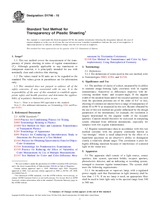We need your consent to use the individual data so that you can see information about your interests, among other things. Click "OK" to give your consent.
ASTM D1746-15
Standard Test Method for Transparency of Plastic Sheeting
STANDARD published on 1.4.2015
The information about the standard:
Designation standards: ASTM D1746-15
Note: WITHDRAWN
Publication date standards: 1.4.2015
SKU: NS-585731
The number of pages: 4
Approximate weight : 12 g (0.03 lbs)
Country: American technical standard
Category: Technical standards ASTM
The category - similar standards:
Annotation of standard text ASTM D1746-15 :
Keywords:
clarity, plastic, regular transmittance, sheeting, transmittance, transparency,, ICS Number Code 83.140.10 (Films and sheets)
Additional information
| Significance and Use | ||||||||||||||||||||
|
4.1 The attribute of clarity of a sheet, measured by its ability to transmit image-forming light, correlates with its regular transmittance. Sensitivity to differences improves with decreasing incident beam- and receptor-angle. If the angular width of the incident beam and of the receptor aperture (as seen from the specimen position) are of the order of 0.1° or less, sheeting of commercial interest have a range of transparency of about 10 to 90 % as measured by this test. Results obtained by the use of this test method are greatly influenced by the design parameters of the instruments; for example, the resolution is largely determined by the angular width of the receptor aperture. Caution should therefore be exercised in comparing results obtained from different instruments, especially for samples with low regular transmittance. 4.2 Regular transmittance data in accordance with this test method correlate with the property commonly known as “see-through,” which is rated subjectively by the effect of a hand-held specimen on an observer's ability to distinguish clearly a relatively distant target. This correlation is poor for highly diffusing materials because of interference of scattered light in the visual test. |
||||||||||||||||||||
| 1. Scope | ||||||||||||||||||||
|
1.1 This test method covers the measurement of the transparency of plastic sheeting in terms of regular transmittance (Tr). Although generally applicable to any translucent or transparent material, it is principally intended for use with nominally clear and colorless thin sheeting. 1.2 The values stated in SI units are to be regarded as the standard. The values given in parentheses are for information only. 1.3 This standard does not purport to address all of the safety concerns, if any, associated with its use. It is the responsibility of the user of this standard to establish appropriate safety and health practices and determine the applicability of regulatory limitations prior to use. Note 1: There is no known ISO equivalent to this
standard.
Note 2: For additional information, see Terminology
E284 and Practice
E1164.
|
||||||||||||||||||||
| 2. Referenced Documents | ||||||||||||||||||||
|
We recommend:
Technical standards updating
Do you want to make sure you use only the valid technical standards?
We can offer you a solution which will provide you a monthly overview concerning the updating of standards which you use.
Would you like to know more? Look at this page.




 Cookies
Cookies
